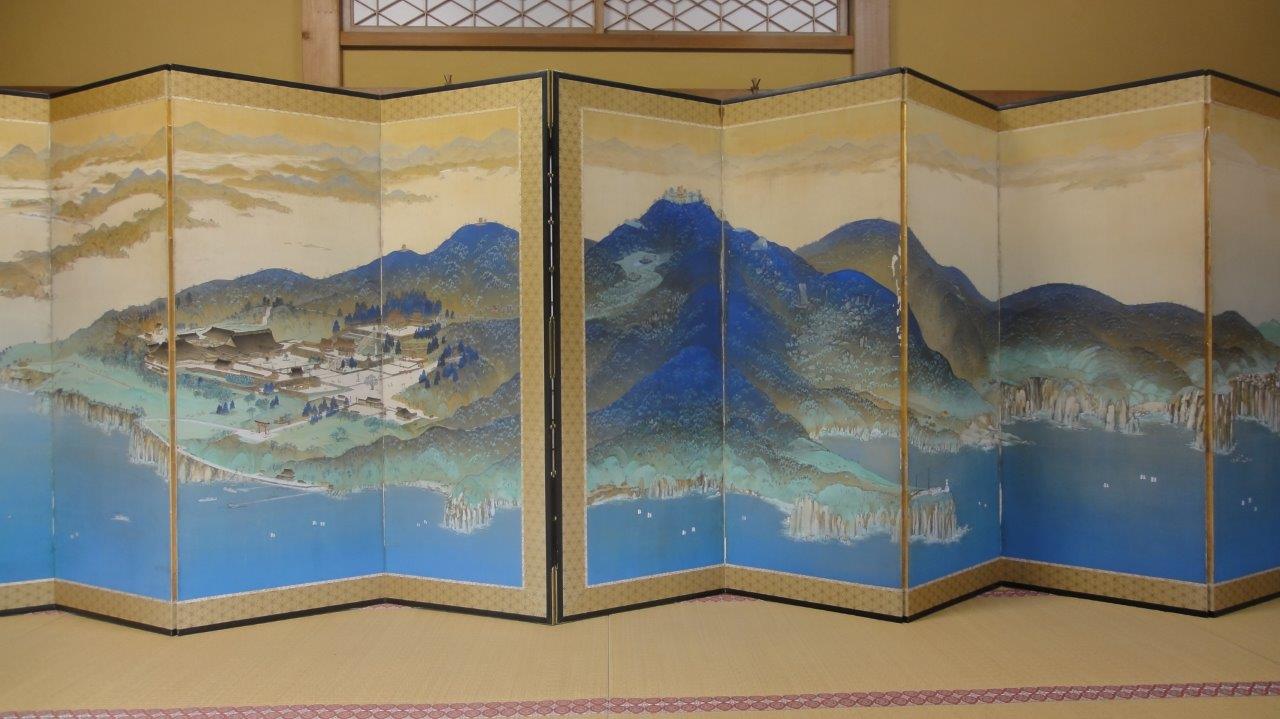今から凡そ1270年前、聖武天皇の御世 天平21年(西暦749年)に、陸奥の国守百済王敬福が朝廷に黄金を献上しました。大仏建立に黄金を必要としていた天皇は大いに喜ばれ、年号を天平勝宝と改められました。
It was about 1270 years ago, on the 21styear of the Tenpyo age under Emperor Shomu (A.C. 749), when the governor of the land of Mutsu (now kn as Tohoku), Kudaranokonikishi Kyofuku, presented some gold to the imperial court. The emperor, who was in need of gold for the construction of the great Daibutsu in Nara, was deeply pleased with this gift and renamed the age of his reining to Tenpyo-Shohou (adding the meaning ‘winning of treasures’ to the original Tenpei name which means ‘peacefulness’).
この史実は、我が国最初の産金として有名なことであり、この祝事に因み、同2年牡鹿連宮麿等が相議り国守に請願し、秀麗の地金華山に金を司る金山毘古神 (かなやまひこのかみ)・ 金山毘賣神 (かなやまひめのかみ)を奉祀し神社を創建したのが、金華山黄金山神社であります。
This historical fact is known as the first record of gold mining in Japan. Two years later, as a result of a petition to the governor by Ojikanomurajimiyamaro and other local leaders, a shrine was built on the beautiful island of Kinkasan in celebration of the first gold found in this nation. This shrine had two gods: Kanayamahiko-no-kami and Kanayamahime-no-kami (god and goddess of gold), and was named‘Kinkasan Koganeyama Shrine’.
中古以来、神仏習合時代は 辯財天 (べんざいてん)を守護神として、別当寺を金華山大金寺と称し多くの信仰を集め、女人禁制を敷きました。
During the age of syncretization of Shinto with Buddhism, a temple called ‘Kinkasan Daikinji’ was built, and under the guardian god Benzaiten, the island was worshipped by many people. At this time, only men were allowed to visit Kinkasan.
金華山大金寺は、平泉の陸奥守藤原秀衡公、石巻城主葛西三郎清重公等、時の権力者により多大の御寄進を受け、荘厳美麗を極めました。即ち、 東奥の三大霊場 (出羽三山・恐山・金華山)として修験者が次々と来山し、修行を積んだ者は、金華山信仰を各地で広めていったのです。また、金華山は、江ノ島・厳島・竹生島・天河と共に日本五大辯財天の霊地ともされます。
The temple Kinkasan Daikinji received generous contributions from men of power such as Fujiwara Hidehira of Hiraizumi (Governor of the Tohoku region), and Kasai Saburo Kiyoshige (Lord of Ishinomaki Castle), and it then reached its height of glory and beauty. It became known as one of the three most sacred places in Northern Japan, along with Dewa Sanzan and Osorezan. Many priests visited the island for ascetic practices and went on to spread the Kinkasan beliefs to other regions. Kinkasan is also known as one of the five Benzaiten shrines in Japan, along with Enoshima, Itsukushima, Chikubushima, and Tenkawa.
天正の乱の兵火による焼失後も、下野国岩倉の僧成蔵坊長俊(栃木県日光山の僧正)により大金寺は再興され、代々真言宗にて祭祀が奉じられました。その後、伊達政宗公を始め伊達家累代の熱心な崇敬のもと、年毎に隆盛をきたしました。
Even after the fire of the Battles of Tenshou, Daikinji temple was rebuilt by Priest Choshun of Shimotsuke-Iwakura (head priest of the sacred mountain of Nikko in Tochigi Prefecture) and continued to be celebrated by the Buddhist Shingon sect. Thereafter, Kinkasan prospered under the strong support of the Date family.(The most famous among the family is Date Masamune.)
そして明治2年には、神仏分離令により、仏号を除き黄金山神社と復古し、女人禁制も解除されました。この際、御祭神も金山毘古神・金山毘賣神の二柱とし、頂上奥殿(奥ノ院)大海祇神社(おおわだつみじんじゃ)の御祭神には大綿津見神(おおわだつみのかみ)・市杵島姫神(いちきしまひめのかみ 仏号・辯財天)外二柱が奉祀されました。
With the ordinance of separation of Shinto and Buddhism in the beginning of the Meiji period, Kinkasan regained its status as a Shinto shrine. The two gods Kanayamahiko-no-kami and Kanayamahime-no-kami were once again celebrated as the main gods of the shrine, while two more gods (Owadatsumi-no-kami and Ichikishimahime-no-kami) were enshrined in Owadatsumi Shrine located at the top of the island. Women were then welcomed to the island again.
![金華山黄金山神社【宮城県石巻市 みちのく 霊島】Kinkasan Koganeyama Shrine [Ishinomaki City, Miyagi Prefecture Holy Island of the Michinoku]](https://kinkasan.jp/wp-content/uploads/2018/04/logo03.gif)

